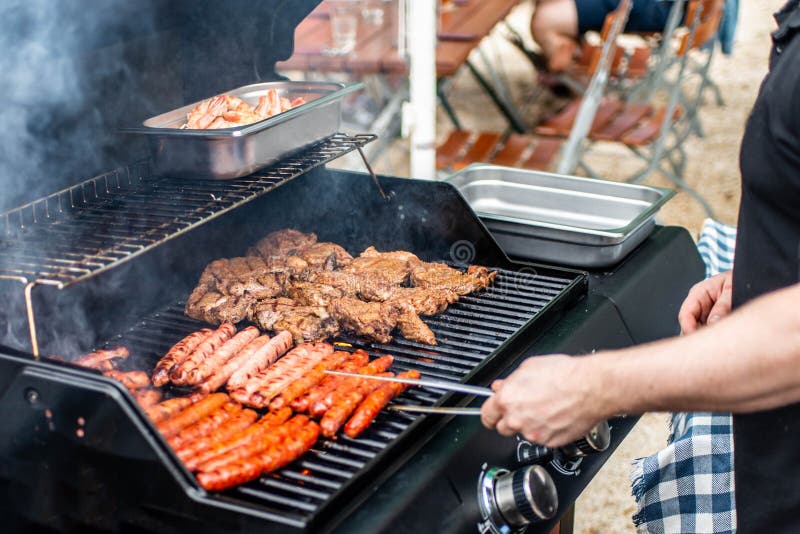
For many, the apron is just a simple piece of cloth worn to protect clothing from spills and stains. But for barbecue enthusiasts, aprons hold a deeper significance. The history of aprons is not just a tale of functional fashion; it is a story of culinary culture, craftsmanship, and the evolution of cooking itself. From the rustic fires of ancient times to the sophisticated grills of today, aprons have been a constant companion, evolving with the art of grilling. In this article, we delve into the evolution of aprons through history, exploring how this humble garment has transformed over the centuries.

Early Beginnings: Aprons in Ancient Times
The history of aprons dates back to ancient civilizations, where they served both practical and symbolic purposes. In ancient Egypt, aprons were worn by priests and were often adorned with religious symbols. These early aprons were made from simple materials like linen and were primarily used to signify status and purity.
In contrast, ancient Greeks and Romans used aprons as a practical garment for workers and craftsmen. These early aprons were designed to protect the wearer's clothing from dirt and damage, much like the aprons we use today. As grilling and cooking over open fires became more common, aprons became an essential tool for protecting both the cook and the food.
Medieval and Renaissance Aprons: A Symbol of Trade and Craft
During the medieval and Renaissance periods, aprons became more specialized, reflecting the trades and crafts of the time. Blacksmiths, bakers, and butchers each had their own distinct apron styles, designed to meet the unique needs of their professions. These aprons were often made from durable materials like leather, offering maximum protection in demanding environments.
For barbecue enthusiasts, the apron became synonymous with the craft of cooking. As grilling techniques evolved, so did the design and materials of aprons. The protective quality of the apron was enhanced, allowing cooks to work more freely and confidently over open flames.
The Industrial Revolution: A New Era for Aprons
The Industrial Revolution brought significant changes to the design and production of aprons. With the advent of new materials and manufacturing techniques, aprons became more widely available and affordable. Cotton and denim aprons became popular choices for their comfort and durability.
During this time, aprons also began to take on a more aesthetic role, with colorful patterns and decorative elements becoming more common. This shift was reflected in the world of barbecue, where aprons became not just a tool for protection but a statement of personal style and culinary passion.
Modern Aprons: Blending Tradition with Innovation
Today, aprons continue to evolve, blending traditional designs with modern innovations. For barbecue enthusiasts, aprons have become an essential part of the grilling experience. From reinforced pockets for tools to flame-retardant fabrics, modern aprons are designed to meet the demands of today's grill masters.
The integration of technology has also influenced apron design. Aprons with built-in thermometers, spice holders, and even smartphone pockets are now available, enhancing the convenience and efficiency of the grilling process. This fusion of tradition and innovation is a testament to the enduring legacy of aprons in the culinary world.
A Cultural Perspective
Apart from their functional role, aprons have also played a significant part in cultural traditions worldwide. In many cultures, aprons are a symbol of hospitality and care, often passed down through generations as cherished family heirlooms. This cultural significance is evident in various traditional attire where aprons are prominently featured.
For a deeper understanding of this cultural impact, you can read more about the cultural significance of aprons on our blog.
Aprons in the Barbecue World
In the realm of barbecue, aprons have become iconic symbols of the grilling lifestyle. Whether emblazoned with humorous slogans or personalized monograms, aprons express the personality and passion of the grill master. They serve as a badge of honor for those who dedicate themselves to the art of grilling.
For barbecue enthusiasts looking to explore different apron styles, you might find this guide on the different types of aprons insightful.
Conclusion
The evolution of aprons through history is a fascinating journey that reflects the changes in culinary practices and cultural values over time. From ancient symbols of status to modern tools of the trade, aprons have continuously adapted to meet the needs of those who wear them. For barbecue enthusiasts, aprons are an integral part of the grilling experience, symbolizing both protection and passion.
As we continue to explore new grilling techniques and technologies, the apron will undoubtedly continue to evolve, remaining a beloved and essential garment for generations to come.

FAQ
Why are aprons important in grilling?
Aprons are crucial in grilling as they provide protection against heat, spills, and stains, allowing the grill master to work confidently without worrying about clothing damage.
What materials are best for barbecue aprons?
Materials like cotton, denim, and leather are popular choices for barbecue aprons due to their durability and heat-resistant properties. Some modern aprons also incorporate flame-retardant materials for added safety.
Can aprons be personalized for barbecue enthusiasts?
Yes, many barbecue enthusiasts choose to personalize their aprons with monograms, logos, or slogans that reflect their personality and grilling style. Personalized aprons make for great gifts and add a unique touch to the grilling experience.



